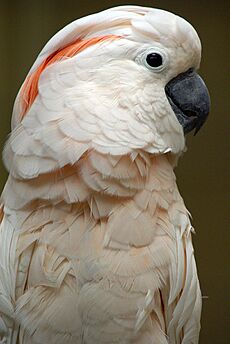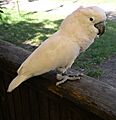Salmon-crested cockatoo facts for kids
Quick facts for kids Salmon-crested cockatoo |
|
|---|---|
 |
|
| At Cincinnati Zoo | |
| Conservation status | |
| Scientific classification |
The salmon-crested cockatoo (Cacatua moluccensis), also called the Moluccan cockatoo, is a type of cockatoo. It lives only in the Seram islands in eastern Indonesia. This means it is endemic to that area. It is one of the biggest white cockatoos, growing up to about 46 to 52 centimeters (18 to 20 inches) tall. It can weigh up to 850 grams (about 1.9 pounds). Female cockatoos are usually a bit smaller than males.
These birds have beautiful white-pink feathers with a soft peachy glow. Their underwings and tail feathers have a hint of yellow. They have a large crest on their head that they can raise up. When they lift their crest, bright red-orange feathers show, which can scare away animals that might try to harm them. They also raise their crest when they are excited or showing other strong feelings. Some people say their crest looks like a "flamingo" color. Salmon-crested cockatoos are known for having one of the loudest calls among parrots. When kept as pets, they can be very good at copying sounds and words.
In the wild, salmon-crested cockatoos live in lowland forests that are below 1,000 meters (3,300 feet) in height. They mostly eat seeds, nuts, and fruit, including coconuts. There is also proof that they eat insects from the ground. Pet Moluccan cockatoos can get anemia (a blood problem) if they don't get enough protein in their diet.
Contents
About This Bird
The salmon-crested cockatoo was first officially described in 1788 by a German scientist named Johann Friedrich Gmelin. He gave it the scientific name Psittacus moluccensis. Later, in 1817, it was placed in the genus Cacatua, where it still belongs today. There are no different types or subspecies of the salmon-crested cockatoo.
Where They Live
The salmon-crested cockatoo is found only in the Seram islands, which are part of eastern Indonesia. A small group of these birds has also started living on the Hawaiian island of Oahu. While some have been seen in Puerto Rico, these are likely pet birds that escaped, and they haven't been seen reproducing there.
Protecting Them in the Wild
The salmon-crested cockatoo is considered a vulnerable species. This means their numbers are decreasing, and they could be in danger of disappearing if we don't protect them. Since 1989, it has been listed on Appendix I of CITES. This rule makes it illegal to buy or sell these birds from the wild across countries. You can only legally trade birds that were born and raised in captivity, and even then, you need special CITES papers.
Their numbers have gone down because people illegally catch them to sell as pets. Also, their homes are being destroyed. At one point, over 6,000 birds were being taken from the wild each year! They have a strong population in Manusela National Park on Seram, but even there, some illegal trapping still happens today.
Keeping Them as Pets
It is no longer allowed to bring salmon-crested cockatoos into the United States from the wild. However, many are now being bred in captivity. People like them as pets because they are beautiful and can be trained. This makes them popular in bird shows.
Salmon-crested cockatoos are thought to be one of the most challenging parrots to keep as pets. This is because they are very smart, quite large, and can be extremely loud. Their calls can be as loud as 129 decibels, which is one of the loudest sounds made by any bird! They also need to chew on things a lot.
Moluccan cockatoos need a very big and strong cage or aviary (a large enclosure for birds). They are very social birds and can be extremely loving and gentle with their owners. However, if a young cockatoo gets too much attention and cuddling, it might not learn how to play with toys or find its own entertainment.
These cockatoos need a lot of attention and things to do to stay healthy and happy. Their human caregivers need to spend time with them and train them. They also need chewable toys and toys that make them work for their food. Like most large cockatoos, salmon-crested cockatoos can develop health or behavior problems, such as feather-plucking (pulling out their own feathers) or becoming aggressive. This can happen if they don't have the right environment, enough attention, or fun activities.
In captivity, salmon-crested cockatoos can live for a very long time. One bird was known to live to be 92 years old!
Reproduction
Moluccan cockatoos usually breed once a year. This happens between December and March, which is when plants grow the most and there is plenty of food available.
Gallery








